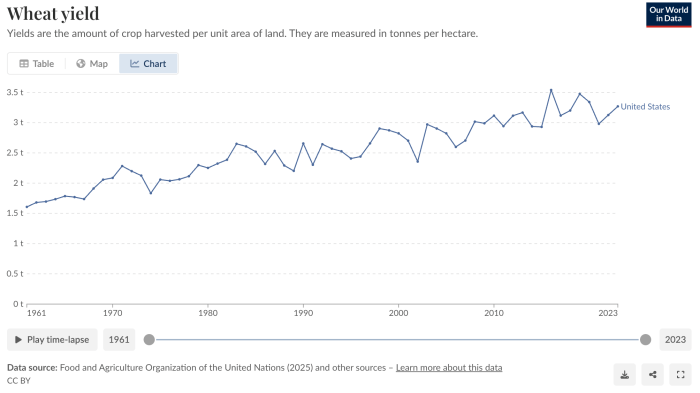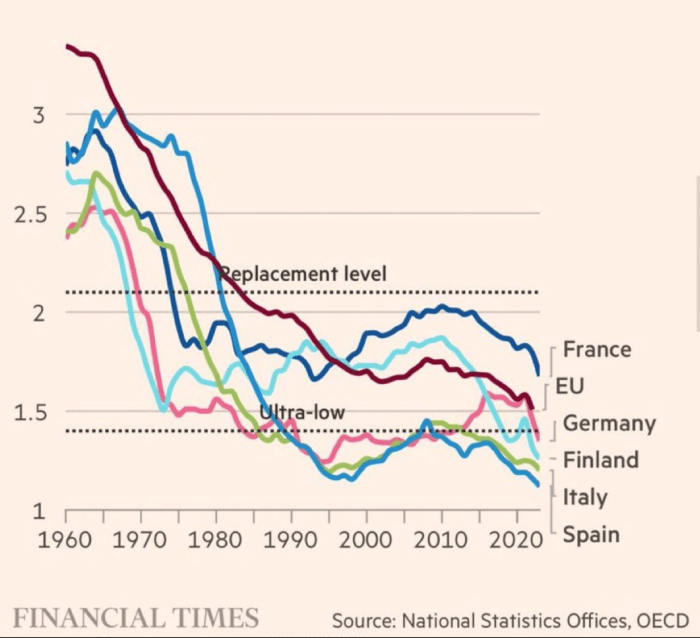https://wmbriggs.substack.com/p/a-reason-the-birthrate-is-so-low
A Reason The Birthrate Is So Low: Food

In the 1970s the fear—there is always fear, much of it imaginary or exaggerated—was mass starvation. There were soon, they said, to be too many people, which would lead to disastrous pressure on the food supply, and we’d run out. Some said this was to be because of Global Cooling, which was the environmental theory in vogue then. Others, like the continuously venerated and awarded Paul Ehrlich, said it was because of mankind’s predilection to breed.
Not to bore us with a glut of data, but here is wheat production in the good ol’ United States from 1961 to 2023. Up, up, and away.

That same shape is found for crops of all kinds all across the world.
It seems the 1970s environmentalists got the direction of cause backwards, a common failing. It wasn’t that more people were eating all the food, it was that there were more people because there was more food. Lack of food, as all history teaches, depresses breeding. Of course, there are inescapable feedbacks in the world. Lock people on a cruise ship, don’t allow it to dock or communicate with any other vessel, and the environmentalist theory of over-population would soon hold.
The starvation theory doesn’t hold where innovation is possible. Don’t forget that most of the native (non-immigration) population increase over the last century was in those places which did not historically have ready access to buffets. It was largely thanks to to efforts of “racists” and their (then) Reality-oriented science that food was made to grow reliably and in great quantity.
The effects of food are not wholly linear. When there is little, or none, people cannot afford the calories to breed. When there is enough, they can and do. When there is too much, when people are saturated and spoiled in plenty, they can’t be bothered to breed. Eating, after all, is one of the pleasures which rivals sex. (And explains why many priests tend to run to fat.) There is always room for one more bite. Once you eat too much, the sexual drive has been known to whither.
There is, as is obvious, an enormous and obvious ceteris paribus attached to that theory. Things are, of course, not equal. It’s that inequality that is our interest.
Here is a picture, one of a familiar genre, making the rounds. Average birth rate for several countries:

Same kind of curve is found all over, again for native populations. You will have noticed it is the inverse of the wheat curve and other foodstuffs. How much of that is coincidence and how much causal is our question.
That “Ultra-low” in the plot seems to be a marketing term, but there isn’t much dispute about the “Replacement level”, though there is some plus or minus to it. In times of war and other terrific negative pressure on population, 2.1 children per woman isn’t enough. In times of plenty, it’s about right given the adventurousness of men. (It’s interesting in discussions of this topic Fantastists give up their notion that men pretending to be women are “really” women.)
I recall reading recently a story of a young man in South Korea, which has a graph like this, coming in at the bottom of rates. He lamented the affordability and crowdedness of Seoul, and the pressures he had to find work. Great crowds flowing into cities drove the cost of everything up, ensuring he had to spend the bulk of his waking hours not pursuing breeding.
There are many reasons people don’t breed, and I think an under-appreciated reason is this. That there are now more than ever, more of us, wherever you go. South Korean birth rates are, some reports say, around 0.78, which means many women now never get pregnant. But the population of South Korea, around 52 million, is as high as it has ever been. True, it’s now older people, but old and young take up as much space, and eat about the same, in gross terms. If you stroll through Seoul, you cannot escape the notion that there are lots and lots of people. Maybe even too many.
The leisure that should have followed the ample supply of food has not resulted in actual time off. People are as busy as ever, and maybe busier, and that is because there are so many of us we’re still catching on creating places to put them all and, to coin a phrase, in a manner in which they have become accustomed. Consider one of the prime arguments against wanton immigration is that it drives costs up, particularly housing costs. And this forces people to concentrate more on bringing in more of the green stuff to sustain their living.
Consider, too, the freedom from having to find food first and forecast did allow time for lots of other things. Some good, some bad.
The bad are things like women’s Equality, which led to women eschewing motherhood, interesting ways to avoid the consequences of sex, and the indulgence of killing, at mass scale, children implanted in women. Just so the woman can pursue non-family ends, such as finding enough money to afford to live in over-crowded cities and still go shopping. Men allowed this Equality, and embraced it finding in it their own greater freedoms, even going as far as substituting real women for online simulacra.
The good, or seeming good, was the invention of all the toys we have grown used to. Some of these aided breeding, some not. But the desire to have them again pushes people toward making the money to afford them, There is always a limit of time and what can be pursued. Picture in your mind the endless lines of young men waiting to buy the latest iteration of Gadget version 14.000023, version 14.000022 having lost its allure a week ago.
It really is the old litany: good times make soft men, soft men make hard times, and et cetera. There is a whole story here, rich with detail, that is beyond us today (we haven’t even considered the rank celebration of non-procreative sexual activities, i.e. “Pride”). The main point is: the population increase caused by the increased food supply is only now aging out and going under. This will accelerate in the coming decades, and begin to fall when that first population boom fades.
Soon enough, say fifty to a hundred years, there will again seem that there aren’t too many people around. The effects won’t be uniform geographically, of course, and the cost of new toys will still play its large part. But the most major cost, finding abodes, ought to fall with the population. And that will lessen the pressure to pursue money. Which will allow more time to breed.


